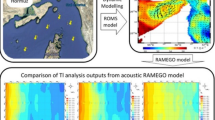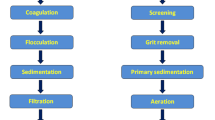Abstract
Negative impacts are caused by oil spills on coastal ecosystems. In the phenomenon of oil spreading, the knowledge of the physical properties of the pollutant, such as velocities and positions, is of fundamental importance for the adoption of timely contingency measures to protect the environment (Fraga Filho, Smoothed Particle Hydrodynamics: Fundamentals and Basic Applications in Continuum Mechanics, 2019). This paper presents a Lagrangian particle modelling for the prediction of the oil slick diameter in the first stage of the oil spreading on a calm sea. At the first studies on the oil spreading (Fay, The Spread of Oil Slicks on a Calm Sea, 1969; Fay, Physical Processes in the Spread of Oil on a Water Surface, 1971), curves were adjusted to laboratory experimental data. The modelling employed in this work is based on the continuum Navier-Stokes equations, and the Smoothed Particle Hydrodynamics (SPH) method has been used to obtain the solution for the conservation equations of mass and momentum. The oil-water interface was treated using a reflective treatment. The solution achieved was compared to the oil slick diameter predicted by Fay’s equation, and an error lower than 1% was found.








Similar content being viewed by others
Data availability
All data generated or analysed during this study are included in this published article.
Change history
03 June 2021
A Correction to this paper has been published: https://doi.org/10.1007/s11356-021-14684-x
Abbreviations
- B :
-
Term related to the fluctuations of the fluid density
- CR:
-
Coefficient of restitution of kinetic energy
- CF:
-
Coefficient of friction
- (C 1)N :
-
Coordinate of the position of the centre of mass of the particle, perpendicular to the plane, at the end of the numerical iteration, in a movement without obstacles, before the reflection
- (C f)N :
-
Coordinate of the position of the centre of mass of the particle, perpendicular to the plane, after the reflection
- D :
-
Oil slick diameter in a certain instant of time
- D 0 :
-
Oil slick diameter at the initial instant of time
- d:
-
Distance between the centre of mass of the particle and the collision plane
- dx:
-
Horizontal distance between two adjacent centres of mass at the initial particle setup
- dz:
-
Vertical distance between two adjacent centres of mass at the initial particle setup
- d/dt:
-
Lagrangian (or material) derivative
- g :
-
Acceleration due to gravity
- g :
-
Magnitude of the gravitational acceleration
- h :
-
Smoothing length
- h o :
-
Initial height of the oil
- h m :
-
Mean oil slick thickness
- kh :
-
Radius of the domain of influence
- k 1 :
-
Constant in Fay’s equation
- m :
-
Mass
- n :
-
Number of particles inside the support radius
- n d :
-
Number of domain dimensions
- P :
-
Absolute pressure composed of two parcels: dynamic pressure and hydrostatic pressure, due to the fluid column over the analysed point
- P a :
-
Absolute pressure on the fixed particle
- P b :
-
Absolute pressure on the neighbouring particle
- P dyn(a) :
-
Dynamic pressure on the fixed particle
- R :
-
Relation between the distance of the fixed and neighbouring particle and the smoothing length
- r :
-
Particle radius
- t:
-
Time
- t f :
-
Final time instant of the gravity-inertial spreading
- v :
-
Fluid velocity
- v a :
-
Velocity of the reference (or fixed) particle
- \( {\mathbf{v}}_a^{\ast } \) :
-
Velocity of the fixed particle, after the XSPH correction
- v b :
-
Velocity of the neighbouring particle
- W :
-
Kernel interpolation function
- X a :
-
Position of the fixed particle
- X b :
-
Position of the neighbouring particle
- xa :
-
Abscissa of the fixed particle
- xb :
-
Abscissa of the neighbouring particle
- V :
-
Volume of the oil spilled
- (v p)N :
-
Magnitude of the particle’s velocity component perpendicular to the collision plane before the collision
- (v col)N :
-
Magnitude of the particle’s velocity component perpendicular to the collision plane immediately after the collision
- (v p)T :
-
Magnitude of the particle’s velocity component tangential to the collision plane before the collision
- (v col)T :
-
Magnitude of the particle’s velocity component tangential to the collision plane immediately after the collision
- z a :
-
Ordinate of the fixed particle
- z b :
-
Ordinate of the neighbouring particle
- α D :
-
Kernel’s normalization constant
- γ :
-
Parameter in the Tait equation
- η :
-
Parameter ranging from 0.0 to 1.0 used in the XSPH correction
- ΔD :
-
Differences between the predicted oil slick diameters (Fay and SPH results)
- Δ w :
-
Relation between oil and water densities
- ρ :
-
Fluid density
- ρ a :
-
Density of the fixed particle
- \( {\rho}_a^{\ast } \) :
-
Corrected density of the fixed particle
- ρ b :
-
Density of the neighbouring particle
- ρ o :
-
Density of the fluid at rest
- ρ w :
-
Density of the water
- ρ oil :
-
Density of the oil
- \( {\left(\frac{1}{\rho}\frac{\partial P}{\partial z}\right)}_a^{\ast } \) :
-
Component of the pressure gradient acting on the fixed particle, corrected by the CSPM method, per unit mass in the x direction
- \( {\left(\frac{1}{\rho}\frac{\partial P}{\partial z}\right)}_a^{\ast } \) :
-
Component of the pressure gradient acting on the fixed particle, corrected by the CSPM method, per unit mass in the y direction
- \( \upsilon \) :
-
Kinematic fluid viscosity
- υ a :
-
Kinematic viscosity of the fixed particle
- ∇ :
-
Mathematical vector operator nabla
References
Chebbi R (2014) Viscous-gravity spreading of oil on water: modeling and challenges. Int J Chem Eng Appl 5(2) http://www.ijcea.org/papers/375-L3016.pdf. Accessed 20 January 2020:186–189
Chen JK, Beraun JE, Carney TC (1999) A corrective smoothed particle method for boundary value problems in heat conduction. Int J Num Meth Engng 46:231–252. https://doi.org/10.1002/(SICI)1097-0207(19990920)46:2<231::AID-NME672>3.0.CO;2-K
Courant R, Friedrichs K, Lewy H (1967) On the partial difference equations of mathematical physics. IBM J 11(2):215–234. https://doi.org/10.1147/rd.112.0215
Fay JA (1971) Physical processes in the spread of oil on a water surface. International Oil Spill Conference Proceedings, Washington, pp 463–467 http://www.dtic.mil/dtic/tr/fulltext/u2/726281.pdf. Accessed January 20, 2020
Fay JA (1969) The spread of oil slicks on a calm sea. In: Hoult DP (ed) Oil on the sea, Ed. Plenum Press, New York, pp 53–64. https://doi.org/10.1007/978-1-4684-9019-0_5
Fraga Filho CAD (2019) Smoothed Particle Hydrodynamics: fundamentals and basic applications in continuum mechanics. Springer Nature, Cham
Fraga Filho CAD (2018) On the boundary conditions in Lagrangian particle methods and the physical foundations of continuum mechanics. Contin Mech Thermodyn 31:475–489. https://doi.org/10.1007/s00161-018-0702-2
Fraga Filho CAD (2017a) A SPH model for prediction of oil slick diameter in the gravity-inertial spreading phase. In: Proceedings of the V International Conference on Particle-based Methods. Fundamentals and Applications – PARTICLES 2017, Wriggers P, Bischoff M, Oñate E, Owen DRJ, & Zohdi T (Eds), p. 898–909, Hannoner
Fraga Filho CAD (2017b) An algorithmic implementation of physical reflective boundary conditions in particle methods: collision detection and response. Phys Fluids 29(11):113602. https://doi.org/10.1063/1.4997054
Lehr WJ, Fraga RJ, Belen MS, Cekirge HM (1984) A new technique to estimate initial spill size using a modified Fay-type spreading formula. Mar Pollut Bull 15(9):326–329. https://doi.org/10.1016/0025-326X(84)90488-0
Monaghan JJ (1989) On the problem of penetration in particle methods. J Comput Phys 82(1):1–15. https://doi.org/10.1016/0021-9991(89)90032-6
Sebastião P, Soares CG (1995) Modeling the fate of oil spills at sea. Spill Sci Technol Bull 2(2–3):121–131. https://doi.org/10.1016/S1353-2561(96)00009-6
Spaulding ML (2017) State of the art review and future directions in oil spill modelling. Mar Pollut Bull 115:7–19. https://doi.org/10.1016/j.marpolbul.2017.01.001
Stolzenbach KD, Madsen OS, Adams EE, Pollack AM, Cooper CK (1977) A review and evaluation of basic techniques for predicting the behavior of surface oil slicks. Report No. MITSG 77-8, Massachussets Institute of Technology https://repository.library.noaa.gov/view/noaa/9623/Print. Accessed 20 Jan 2020
Violeau D, Buvat C, Abed-Meraim K, De Nanteuil E (2007) Numerical modelling of boom and oil spill with SPH. Coast Eng 12:895–913. https://doi.org/10.1016/j.coastaleng.2007.06.001
Yang X, Liu M (2013) Numerical modeling of oil spill containment by boom using SPH, Science China Physics. Mech Astron 56(2):315–321. https://doi.org/10.1007/s11433-012-4980-6
Zhang M, Zhang S, Zhang H, Zheng L (2012) Simulation of surface-tension-driven interfacial flow with Smoothed Particle Hydrodynamics method. Comput Fluids 59:61–71. https://doi.org/10.1016/j.compfluid.2012.02.017
Acknowledgements
A sincere thank you to Ana Carolina Vargas do Vale Amaro for her diligent English proofreading of this paper.
Authors’ Information
Carlos Alberto Dutra Fraga Filho was born in Vitória, ES, Brazil. He has a PhD Degree in Environmental Engineering and Master’s Degree in Mechanical Engineering from Federal University of Espírito Santo, Brazil. His research interests include fluid mechanics and transport phenomena, Lagrangian particle modelling, and numerical simulation. Professor Fraga Filho teaches at Federal Institute of Espírito Santo, Brazil, where he develops computational tools for application in solving engineering problems.
Author information
Authors and Affiliations
Contributions
Not applicable.
Corresponding author
Ethics declarations
Competing interests
The author declares that he has no competing interests.
Ethics approval and consent to participate
Not applicable.
Consent to publish
Not applicable.
Additional information
Responsible Editor: Marcus Schulz
Publisher’s note
Springer Nature remains neutral with regard to jurisdictional claims in published maps and institutional affiliations.
Rights and permissions
About this article
Cite this article
Fraga Filho, C.A.D. A Lagrangian analysis of the gravity-inertial oil spreading on the calm sea using the reflective oil-water interface treatment. Environ Sci Pollut Res 28, 17170–17180 (2021). https://doi.org/10.1007/s11356-020-11508-2
Received:
Accepted:
Published:
Issue Date:
DOI: https://doi.org/10.1007/s11356-020-11508-2




